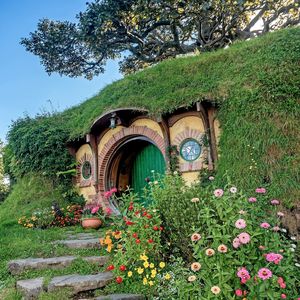
[ad_1]
ONE of the most popular destinations for tourists to New Zealand is not even in New Zealand – it’s in Middle Earth. And it’s inhabited by tiny, mythical hobbits.
The lush dairy and sheep farming landscape around the Waikato region near the town of Matamata, on New Zealand’s north island, about 177km south from Auckland, was used to portray the peaceful Shire region, the setting for the award-winning Lord of the Rings series.
The village of Hobbiton was created here for the movies. It was later rebuilt for The Hobbit trilogy, and now remains as a permanent attraction.
About one in three visitors to New Zealand – about 400,000 a year – visit Hobbiton, which is one of a staggering 158 New Zealand locations used in the filming of the two series.
The green, rolling hills dotted with elm and oak trees could almost be a part of England.
It is hidden from the trappings of the 21st century – houses, roads, electricity poles.

The hobbit holes at Hobbiton movie set reflecting in the small lake. AaronChoi
Until discovered by the films’ producer/director, Sir Peter Jackson, the movie set location was a 500-hectare farm owned by the Alexander family, Craig, Russell and Ian, on which they ran 13,000 sheep and 300 beef cattle.
The choice of the Hobbiton location came after a location scout had searched New Zealand for months.
The Alexander brothers spotted him one day looking over their property with a pair of binoculars. That was in the late 1990s.
One Saturday afternoon, Ian Alexander was at home watching rugby on television when there was a knock on the door.
The scout asked if he could look around the farm.
“Yeah, go to it, as long as you shut the gates so the sheep don’t get mixed up.”
Ian went back to watching the rugby match.
Six weeks later things got serious when Peter Jackson returned with art directors, artists and representatives from Los Angeles.
Six months later, in March, 1999, the Alexanders and Jackson signed a contract.
The next day, the New Zealand Army arrived in a convoy of vehicles including trucks, bulldozers, graders and rollers to begin preparing the set.

The Hobbiton village mill. David Potts
Every day of the year, groups of visitors, five minutes apart, are escorted on a tour through the Hobbiton movie set and are acquainted with the hobbits, their hobbit holes, the Mill and the famous Green Dragon Inn, where visitors can sample the hobbit’s Southfarthing beer.
When you walk through the set you get the same other-world feeling as when reading any of the three books.
During filming up to 500 people were on the set every day. Now the set employs 250 staff to cater for tourists.
Today, five full-time gardeners maintain the set to its original appearance.
At the end of the two-hour guided tour we walk a narrow wooded lane to the mill, cross the graceful double-arched stone bridge for a beer in the Green Dragon pub where hobbits once gathered to drink, gossip and discuss their day.
IF YOU GO:
Tours are often booked out so it is essential to book ahead. Entry is NZ$84 adult, NZ$42 (children aged nine to 16 years). Children under nine years, free. (Note: The set is not wheelchair friendly.) More information at the Hobbiton website: hobbitontours.com.

The visitor information centre located in Matamata, New Zealand. gracethang
Most read book after the bible
THE Lord of the Rings, is an epic, high-fantasy novel written in stages between 1937 and 1949sold it is one of the best-selling novels ever written
Their faces, good-natured, broad, bright-eyed, red-cheeked.
Tolkien claimed the hobbits were more closely related to humans than to elves or even dwarves.
out of 30 total including Best PictureThe series was notable, too, for its innovative special and visual effects.
Made later than The Lord of the Rings series, the first film in , An Unexpected Journey, premiered in November, 2012, the second film, The Desolation of Smaug, in December, 2013, and the third and final film, The Battle of the Five Armies, premiered in December, 2014. They but did not win as many awards.

A hobbit home. David Potts
Creating hobbit holes on a small scale
WHEN the Hobbiton set was rebuilt in 2010 for The Hobbit films, and to become a permanent Lord of the Rings experience, a team of builders, artisans and gardeners took on the rebuild. The original set was faithfully restored.
Each hobbit hole was dug and strong retaining walls and a wooden-framed roof erected. Turf was laid over the roofs. Small windows were added to give the impression the hobbit hole stretched back into the hill.
Bricks were baked in a resident kiln and made to fit around a wooden frame to give the impression of a brick hole. Concrete stones were made on site to construct chimneys. Multiple layers of paint were applied to make the hobbit hole look 500 years old. Vinegar was used to make timber look aged. A special glaze was used in the window frames, through which objects could be admired from outside. The glass in some windows was cooked until it slumped and buckled to make it look older. To create lichen, the art department mixed paint and glue for the moss and added yoghurt to encourage the growth of real moss.
Each hobbit hole door was brightly coloured and the garden in front often reflected the tastes and occupations of the inhabitants.
The filmmakers used sleight-of-hand to create the fantasies – some hobbit-scale holes were made larger so that when normal-sized actors stood in front of them they looked hobbit size. Fences were made on two scales to create differences in sizes of characters. All the props used were also made at different scales to emphasise difference in size.
[ad_2]
Source link Google News









